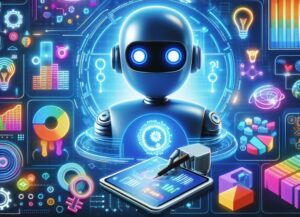Embracing AI in Education: Becoming a Top Student Without Cheating
Top students understand that the invention of the calculator sparked controversy among mathematicians who feared that students would lose their ability to perform basic arithmetic. However, history has shown that calculators have not hindered student learning; instead, they have become a valuable tool for top students to solve complex problems and achieve academic success. Similarly, the emergence of artificial intelligence (AI) tools like ChatGPT has raised concerns about cheating and the potential negative impact on education. Despite these fears, AI can be a powerful tool for students to become top students without compromising their integrity or the learning process.
We strongly recommend that you check out our guide on how to take advantage of AI in today’s passive income economy.
Table of Contents
The Purpose of Education and the Role of AI
To understand how AI can positively influence education, it is essential to examine the purpose of education itself. Education serves three primary goals:
- Preparing students for future careers
- Developing critical thinking skills
- Fostering better citizenship
Preparing Students for Future Careers
With the rapid advancement of AI, it is estimated that 80% of jobs will be disrupted by AI within the next five years. Rather than banning AI in schools, educators should focus on teaching students how to effectively adopt and utilize these tools to become top students and successful professionals in the future.
Developing Critical Thinking Skills
AI-generated content often contains biases and limitations, providing an excellent opportunity for students to develop their critical thinking skills. By engaging with AI outputs and learning to identify biases, students can become top students who are well-equipped to navigate the complexities of the modern world.
Fostering Better Citizenship
AI can help students understand the biases present in society and develop strategies to address them. By using AI as a learning tool, top students can gain a deeper understanding of the world around them and become better citizens who actively work to improve their communities.
Understanding How ChatGPT Works
To effectively use ChatGPT and become a top student, it is crucial to understand how the tool functions. ChatGPT is not an infinite repository of knowledge like Google; instead, it is a language model trained on a vast amount of internet data. When prompted with a question, ChatGPT generates the most probable response based on patterns identified in its training data.
Recognizing Biases in AI-Generated Content
As a result of its training process, ChatGPT’s outputs may contain biases present in the data it has been exposed to. For example, when asked to describe the perfect CEO, ChatGPT may generate a description of a white, middle-aged male, reflecting the lack of diversity in current leadership positions. Top students must recognize these biases and develop strategies to counteract them.
Limitations of ChatGPT
In addition to biases, ChatGPT has other limitations that top students should be aware of:
- Lack of real-world understanding and emotional intelligence
- Inability to verify information and sources
- Potential for generating inaccurate or misleading information
By understanding these limitations, top students can use ChatGPT responsibly and effectively in their academic pursuits.
Creative Ways to Use ChatGPT for Academic Success
Despite its limitations, ChatGPT offers numerous opportunities for students to enhance their learning experience and become top students. Here are eight creative ways to use ChatGPT for academic success:
1. Text Summarization
Top students can use ChatGPT to quickly summarize lengthy texts, such as research papers or book chapters. By providing specific prompts and desired word counts, students can obtain concise summaries that highlight key points and guide their reading.
2. Roleplay and Skill Development
ChatGPT can be used to simulate conversations with experts in various fields, allowing top students to practice and develop skills such as language learning, public speaking, or problem-solving. By engaging in these roleplay scenarios, students can gain valuable insights and improve their abilities.
3. Generating Flashcard Questions
Creating flashcards can be time-consuming, but ChatGPT can help top students streamline the process. By inputting class notes, readings, or other materials, students can prompt ChatGPT to generate relevant questions for their flashcards, saving time and effort.
4. Developing Critical Thinking Skills
Top students can use ChatGPT to generate sample essays on specific topics and then critique the AI-generated content. By identifying weaknesses, biases, and areas for improvement, students actively engage with the material and develop their critical thinking skills.
5. Creative Writing Prompts
For students looking to improve their creative writing skills, ChatGPT can be a valuable tool. By generating unique writing prompts, ChatGPT can inspire top students to explore new ideas and perspectives in their writing.
6. The Socratic Method
ChatGPT can be used to facilitate the Socratic method, a learning technique that involves asking questions to deepen understanding. Top students can engage in a dialogue with ChatGPT, answering questions and seeking clarification to gain a more comprehensive grasp of the subject matter.
7. Homework Feedback and Explanations
Top students can use ChatGPT as a virtual tutor, submitting their completed homework for feedback and guidance. By maintaining a consistent chat history, ChatGPT can provide personalized feedback and explanations tailored to the student’s strengths and weaknesses.
8. Brainstorming and Idea Generation
When working on essays or projects, top students can use ChatGPT as a brainstorming partner. By engaging in a dialogue with the AI, students can explore different perspectives, generate new ideas, and deepen their understanding of the topic.
Best Practices for Using ChatGPT
To ensure the responsible and effective use of ChatGPT, top students should follow these best practices:
- Request citations and independently verify sources
- Identify and address biases in AI-generated content
- Experiment with different prompts to master the skill of guiding AI output
The Future of AI in Education
As AI continues to advance, it will inevitably shape the future of education. Institutions that embrace AI tools like ChatGPT and teach students to use them critically will be better positioned to prepare top students for success in the modern world.
Challenging the Education System
The integration of AI in education will challenge traditional teaching methods and assessment practices. Educators will need to shift their focus from rote memorization to fostering genuine curiosity, intrinsic motivation, and deep learning among students.
Emphasizing Human Skills
While AI can assist with information gathering and idea generation, top students will need to develop uniquely human skills such as creativity, critical thinking, and problem-solving. By leveraging AI tools alongside these skills, students can achieve academic excellence and become leaders in their chosen fields.
Conclusion
Embracing AI tools like ChatGPT in education is not about encouraging cheating or diminishing the value of learning. Instead, it is an opportunity to redefine what it means to be a top student in the age of artificial intelligence. By understanding the potential and limitations of AI, developing critical thinking skills, and using these tools responsibly, students can enhance their learning experience and prepare themselves for success in an AI-driven world.
FAQs:
Q: What is the meaning of top student?
A: A top student is a high-achieving individual who consistently performs at the highest level academically. They excel in their studies, demonstrate a strong work ethic, and often rank among the best in their class or school.
Q: What are the top students called?
A: Top students are often referred to as:
- High achievers
- Academic leaders
- Scholars
- Honor students
- Star pupils
Q: How can you be a top student?
A: To become a top student, you should:
- Set clear academic goals and work diligently towards achieving them
- Develop effective study habits and time management skills
- Actively participate in class and engage with the learning material
- Seek help from teachers, tutors, or peers when needed
- Maintain a healthy balance between academic pursuits and personal well-being
- Continuously challenge yourself to learn and grow
- Embrace the responsible use of educational technology and tools, such as AI, to enhance your learning experience
Q: What do you call a student who is top of the class?
A: A student who ranks at the top of their class is often referred to as:
- Valedictorian: the student with the highest academic rank in their graduating class
- Salutatorian: the student with the second-highest academic rank in their graduating class
- Class topper: a term used to describe the student with the highest grades or scores in their class
- Ace student: a term used to describe a student who excels academically and consistently performs at the top of their class

We strongly recommend that you check out our guide on how to take advantage of AI in today’s passive income economy.




